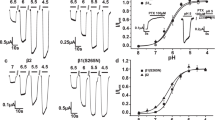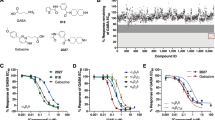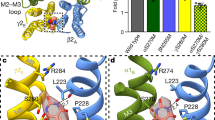Abstract
HIGH affinity saturable binding sites for benzodiazepines (BZs) in mammalian brain have been described1. These sites show stereospecificity, organ and subcellular distribution, and structure–activity relationships reminiscent of other synaptic membrane receptors which have been characterised by ligand binding2,3. The BZ receptor is so highly selective that no known putative neurotransmitters interact with it, thus raising the possibility that the brain contains another unidentified endogenous ligand4,5. Recently, Tallman et al. have reported that γ-aminobutyric acid (GABA) specifically enhances the binding of 3H-diazepam to rat brain membranes6. Considerable biochemical and neurophysiological evidence suggests that GABA may be intimately involved in the mechanism of action of BZs7–10,18. In several neurotransmitter systems, ions seem to have specific effects on the binding of synaptic receptor ligands, presumably because of the intimate association of the receptor with an ion channel. For example, binding of opiate agonists and antagonists is differentially affected by sodium ion11, and Na+ conductance is altered by opiate agonists12. Similarly, specific effects of anions on the receptors for strychnine13 and GABA14 are correlated with observations that the neurophysiological action of these receptors is dependent on alterations in chloride ion conductance15,16. We now report the specific effect of chloride and other anions in enhancing BZ binding to its receptor. We infer that the BZ receptor (recognition site) may be closely associated with a chloride ion channel which is also closely linked to the GABA-recognition site.
This is a preview of subscription content, access via your institution
Access options
Subscribe to this journal
Receive 51 print issues and online access
$199.00 per year
only $3.90 per issue
Buy this article
- Purchase on Springer Link
- Instant access to full article PDF
Prices may be subject to local taxes which are calculated during checkout
Similar content being viewed by others
References
Squires, R. F. & Braestrup, C. Nature 266, 732–734 (1977).
Mohler, H. & Okada, T. Science 198, 849–851 (1977).
Braestrup, C. & Squires, R. F. Proc. Natn. Acad. Sci. U.S.A. 74, 3805 (1977).
Marangos, P. J., Paul, S. M., Greenlaw, P., Goodwin, F. K. & Skolnik, P. Life Sci. 22, 1893–1900 (1978).
Iversen, L. Nature 266, 678 (1977).
Tallman, J. F., Thomas, J. W. & Gallager, D. W. Nature 274, 384–385 (1978).
Costa, E. & Greengard, P. (eds) Mechanisms of Action of Benzodiazepines, Advances in Biochemical Psychopharmacology Vol 14 (Raven, New York, 1975).
Costa, E., Guidotti, A., Mao, C. C. & Suria, A. Life Sci. 17, 167–186 (1975).
Polc, P., Mohler, H. & Haefely, W. Naunyn-Schmiedeberg's Arch. Pharmac. 248, 319–337 (1974).
Macdonald, R. & Barker, J. L. Nature 371, 563–564 (1978).
Pert, C. B. & Snyder, S. H. Molec. Pharmac. 10, 868–879 (1974).
Zieglgänsberger, W. & Bayerl, H. Brain Res. 115, 111–128 (1976).
Young, A. B. & Snyder, S. H. Proc. Natn. Acad. Sci. U.S.A. 71, 4002–4005 (1974).
Enna, S. J. & Snyder, S. H. Molec. Pharmac. 13, 442–453 (1977).
Eccles, J. C. in The Physiology of Synapses, (ed. Eccles, J. C.) (Academic, New York, 1964).
Eccles, J. C., Ann. N. Y. Acad. Sci. 137, 473–495 (1966).
Araki, T., Ito, M. & Oscarsson, O. J. Physiol., Lond. 164, 150–156 (1962).
Gallager, D. W. Eur. J. Pharmac. 49, 133–143 (1978).
Hatefi, Y. & Hanstein, W. G. Proc. natn. Acad. Sci. U.S.A. 62, 1129 (1969).
Mackerer, C. R. & Kochman, R. L. Proc. Soc. exp. Biol. Med. 158, 393–397 (1978).
Creese, I., Pasternak, G., Pert, C. & Snyder, S. Life Sci. 16, 1837 (1975).
Takeuchi, A. & Takeuchi, N. J. Physiol., Lond. 217, 341–358 (1971).
Takeuchi, A. & Takeuchi, N. J. Physiol., Lond. 183, 433–449 (1966).
Krnjević, K. & Schwartz, S. Expl Brain Res. 3, 320–336 (1967).
Mohler, H. & Okada, T. Molec. Pharmac. 14, 256–265 (1978).
Tsai, B. S. & Lefkowitz, R. J. Molec. Pharmac. 14, 540–548 (1978).
Faden, V. B. & Rodbard, D., Scatchard Plot Data Processing. NICHD, NIH, Bethesda.
Rodbard, D. in Receptors for Reproductive Hormones (eds O'Malley, B. W. & Means, A. R.) 289–326 (Plenum, New York, 1975).
Costa, T., Pert, C. & Rodbard, D. in Physical Chemical Aspects of Cell Surface Events in Cellular Regulation (eds DeLisi, C. & Blumenthal, R.) (Elsevier, Amsterdam, in the press).
Author information
Authors and Affiliations
Rights and permissions
About this article
Cite this article
COSTA, T., RODBARD, D. & PERT, C. Is the benzodiazepine receptor coupled to a chloride anion channel?. Nature 277, 315–317 (1979). https://doi.org/10.1038/277315a0
Received:
Accepted:
Issue Date:
DOI: https://doi.org/10.1038/277315a0
This article is cited by
-
Ovarian steroids modify the behavioral and neurochemical responses of the central benzodiazepine receptor
Psychopharmacology (1996)
-
Defeat engenders pentylenetetrazole-appropriate responding in rats: antagonism by midazolam
Psychopharmacology (1994)
-
Chronic brief restraint decreases in vivo binding of benzodiazepine receptor ligand to mouse brain
Molecular and Chemical Neuropathology (1993)
-
Regional Distribution and Kinetics of Three Sites on the GABAA Receptor: Lack of Effect of Portacaval Shunting
Journal of Cerebral Blood Flow & Metabolism (1992)
-
Steroid and barbiturate modulation of the GABAa receptor
Molecular Neurobiology (1989)
Comments
By submitting a comment you agree to abide by our Terms and Community Guidelines. If you find something abusive or that does not comply with our terms or guidelines please flag it as inappropriate.



